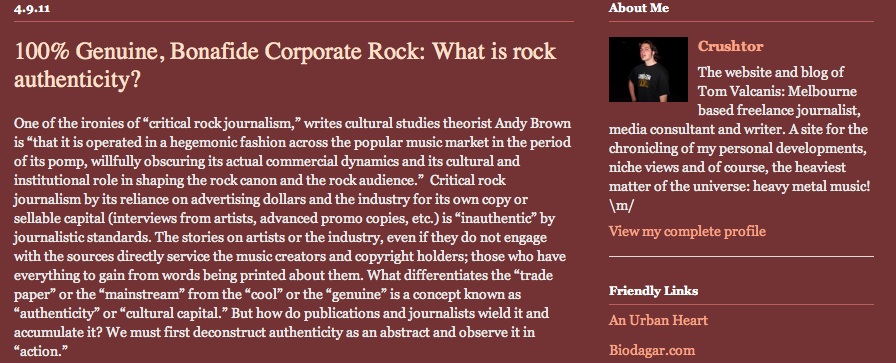Written by Tom Valcanis. His third essay in our collaborative series.
One of the ironies of “critical rock journalism,” writes cultural studies theorist Andy Brown is “that it is operated in a hegemonic fashion across the popular music market in the period of its pomp, willfully obscuring its actual commercial dynamics and its cultural and institutional role in shaping the rock canon and the rock audience.” Critical rock journalism by its reliance on advertising dollars and the industry for its own copy or sellable capital (interviews from artists, advanced promo copies, etc.) is “inauthentic” by journalistic standards. The stories on artists or the industry, even if they do not engage with the sources directly service the music creators and copyright holders; those who have everything to gain from words being printed about them. What differentiates the “trade paper” or the “mainstream” from the “cool” or the “genuine” is a concept known as “authenticity” or “cultural capital.” But how do publications and journalists wield it and accumulate it? We must first deconstruct authenticity as an abstract and observe it in “action.”
Cultural capital is conferred on certain publications, granting them a subcultural “rock authority.” This gives rise to the conception of cultural capital as “cool” or “authenticity.” Whether its journalism thrives in the underground “zine” culture or written for “payola,” traditionally known as the act of labels paying deejays or journalists to promote certain artists, cultural capital is closely linked with “monetary” capital.
With the invention of the printing press and other more advanced technologies such as the internet and television, the “eye becomes more important than the ear” – a system of signification and meaning emerges in the form of a subculture with its own discrete and extensional rituals. Thus we can point toward a rock subculture with its own internal consistencies and tendency for self and other identification. According to the philosopher Heidegger, authenticity is defined to “be one’s own self, as part of the history of one’s community.” In a broader philosophical context, authenticity is to say:
“that his or her actions truly express what lies at their origin, that is, the dispositions, feelings, desires, and convictions that motivate them. Built into this conception of authenticity is a distinction between what is really going on within me – the emotions, core beliefs, and bedrock desires that make me the person I am – and the outer avowals and actions that make up my being in the public world…We commonly suppose that authenticity has a considerable value even if it does not produce such extrinsic goods as wealth, fame, or pleasure.”[1]
The image of a rock band according to rock scholar and critic Simon Frith must have certain characteristics for it to be accepted as “authentic” by people who self-identify as part of the rock subculture and its various sub-divided subcultures almost as much as the sound and arrangement of the music, and be recognized as part of the “subcultural sphere” of rock music. If an artist exists in a rock subculture which is overwhelmingly dominated by corporate interests, how can an artist stay “authentic?” How can a “rocker” such as Bruce Springsteen dress like a working-class, thirty-seven year old “teenager” and be celebrated for it despite his multi-million dollar success?
GO HERE TO READ THE FULL ESSAY. You know you want to.

